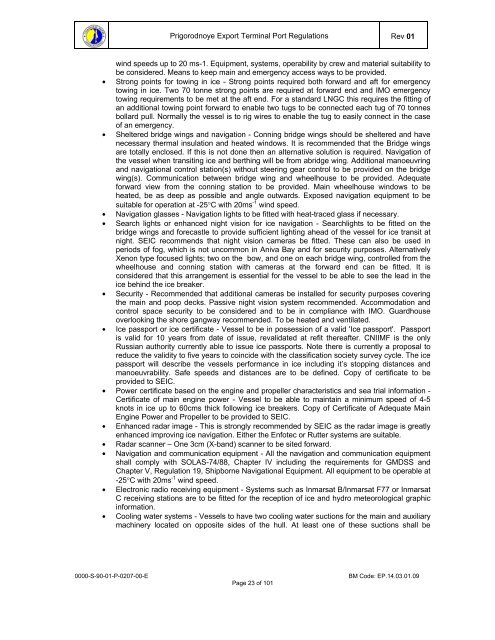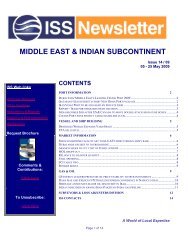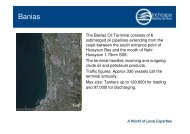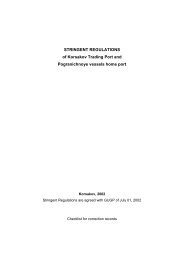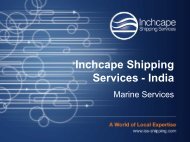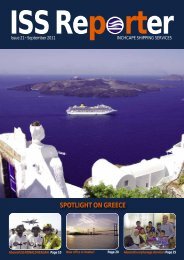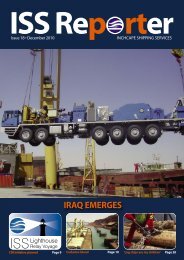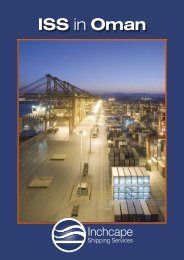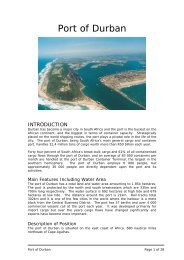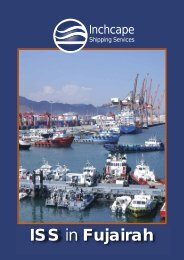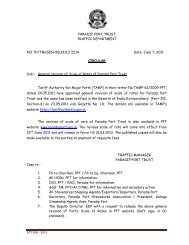Prigorodnoye Export Terminal Port Regulations.pdf - Inchcape ...
Prigorodnoye Export Terminal Port Regulations.pdf - Inchcape ...
Prigorodnoye Export Terminal Port Regulations.pdf - Inchcape ...
Create successful ePaper yourself
Turn your PDF publications into a flip-book with our unique Google optimized e-Paper software.
<strong>Prigorodnoye</strong> <strong>Export</strong> <strong>Terminal</strong> <strong>Port</strong> <strong>Regulations</strong> Rev 01<br />
wind speeds up to 20 ms-1. Equipment, systems, operability by crew and material suitability to<br />
be considered. Means to keep main and emergency access ways to be provided.<br />
• Strong points for towing in ice - Strong points required both forward and aft for emergency<br />
towing in ice. Two 70 tonne strong points are required at forward end and IMO emergency<br />
towing requirements to be met at the aft end. For a standard LNGC this requires the fitting of<br />
an additional towing point forward to enable two tugs to be connected each tug of 70 tonnes<br />
bollard pull. Normally the vessel is to rig wires to enable the tug to easily connect in the case<br />
of an emergency.<br />
• Sheltered bridge wings and navigation - Conning bridge wings should be sheltered and have<br />
necessary thermal insulation and heated windows. It is recommended that the Bridge wings<br />
are totally enclosed. If this is not done then an alternative solution is required. Navigation of<br />
the vessel when transiting ice and berthing will be from abridge wing. Additional manoeuvring<br />
and navigational control station(s) without steering gear control to be provided on the bridge<br />
wing(s). Communication between bridge wing and wheelhouse to be provided. Adequate<br />
forward view from the conning station to be provided. Main wheelhouse windows to be<br />
heated, be as deep as possible and angle outwards. Exposed navigation equipment to be<br />
suitable for operation at -25°C with 20ms -1 wind speed.<br />
• Navigation glasses - Navigation lights to be fitted with heat-traced glass if necessary.<br />
• Search lights or enhanced night vision for ice navigation - Searchlights to be fitted on the<br />
bridge wings and forecastle to provide sufficient lighting ahead of the vessel for ice transit at<br />
night. SEIC recommends that night vision cameras be fitted. These can also be used in<br />
periods of fog, which is not uncommon in Aniva Bay and for security purposes. Alternatively<br />
Xenon type focused lights; two on the bow, and one on each bridge wing, controlled from the<br />
wheelhouse and conning station with cameras at the forward end can be fitted. It is<br />
considered that this arrangement is essential for the vessel to be able to see the lead in the<br />
ice behind the ice breaker.<br />
• Security - Recommended that additional cameras be installed for security purposes covering<br />
the main and poop decks. Passive night vision system recommended. Accommodation and<br />
control space security to be considered and to be in compliance with IMO. Guardhouse<br />
overlooking the shore gangway recommended. To be heated and ventilated.<br />
• Ice passport or ice certificate - Vessel to be in possession of a valid 'Ice passport'. Passport<br />
is valid for 10 years from date of issue, revalidated at refit thereafter. CNIIMF is the only<br />
Russian authority currently able to issue ice passports. Note there is currently a proposal to<br />
reduce the validity to five years to coincide with the classification society survey cycle. The ice<br />
passport will describe the vessels performance in ice including it’s stopping distances and<br />
manoeuvrability. Safe speeds and distances are to be defined. Copy of certificate to be<br />
provided to SEIC.<br />
• Power certificate based on the engine and propeller characteristics and sea trial information -<br />
Certificate of main engine power - Vessel to be able to maintain a minimum speed of 4-5<br />
knots in ice up to 60cms thick following ice breakers. Copy of Certificate of Adequate Main<br />
Engine Power and Propeller to be provided to SEIC.<br />
• Enhanced radar image - This is strongly recommended by SEIC as the radar image is greatly<br />
enhanced improving ice navigation. Either the Enfotec or Rutter systems are suitable.<br />
• Radar scanner – One 3cm (X-band) scanner to be sited forward.<br />
• Navigation and communication equipment - All the navigation and communication equipment<br />
shall comply with SOLAS-74/88, Chapter IV including the requirements for GMDSS and<br />
Chapter V, Regulation 19, Shipborne Navigational Equipment. All equipment to be operable at<br />
-25°C with 20ms -1 wind speed.<br />
• Electronic radio receiving equipment - Systems such as Inmarsat B/Inmarsat F77 or Inmarsat<br />
C receiving stations are to be fitted for the reception of ice and hydro meteorological graphic<br />
information.<br />
• Cooling water systems - Vessels to have two cooling water suctions for the main and auxiliary<br />
machinery located on opposite sides of the hull. At least one of these suctions shall be<br />
0000-S-90-01-P-0207-00-E<br />
Page 23 of 101<br />
BM Code: EP.14.03.01.09


